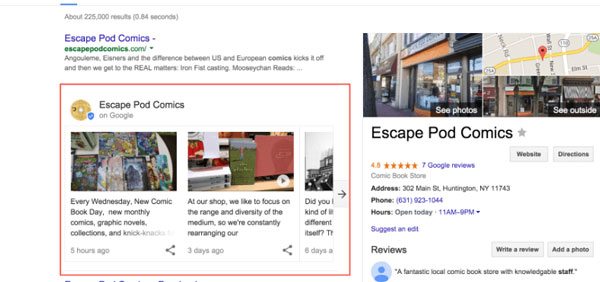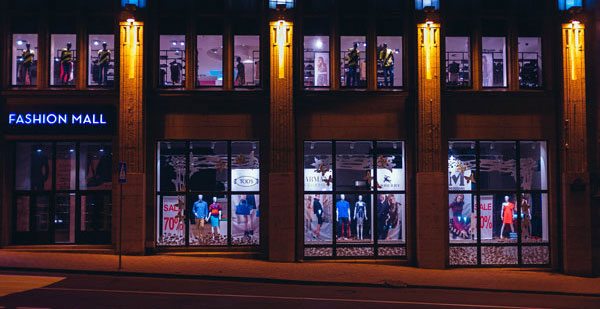Monthly Industry Roundup: August 2017
Location3 News: As the dog days of summer approach, we’re still pushing forward with a couple of new projects with Google along with some more pub from Location3 President Alex Porter.
Last week, Porter, Director of Marketing Josh Allen, and Franchise Account Strategist Boyd Hathaway, made their way to Mountain View, Calif., where they teamed with Google to produce a couple of new videos on paid media strategy for franchise systems. Stay tuned.
Porter added to his portfolio of published material with a “Think Tank” feature in Women’s Wear Daily. Porter explains why blaming online shopping for a loss in retail sales for brick-and-mortar stores misses the target. Read here to find out what Porter calls “the easiest marketing fix in the world”.
And last but not least, on the latest Digital Shoptalk, we meet a few of our valued team members at Location3.
WHAT’S HAPPENING IN LOCAL SEO?
What You Need to Know About Google Posts
Location3 Head of Local Search Nick Neels gives you a quick-hitter on Google Posts, a feature of Google My Business recently released to all verified Google My Business local listings. Neels breaks down the four types of posts and why he’s more optimistic about Posts than the failed Google Plus experiment.
Facebook the Next Big Search Engine?
If there’s been a consistent theme at Location3 in the past few months, it’s the potential for Facebook to become a major player in local search. With Facebook showing an increased focus on local search, Location3 VP of Agency Development Tom Lynch is monitoring the potential of marketing on Facebook and its ongoing battle with Google.
Lynch was recently interviewed by Adotas on how Facebook could become the next big platform for franchise systems and multi-location businesses. Here’s an excerpt from the interview.
Q: How will Facebook be able to compete with Google for market share?
A: With Facebook’s move into local search, the two companies have become real competitors.In most cases, people will turn to Google when conducting a search. This can be done through the Google homepage, Maps, the Chrome app, etc.
But with Facebook’s move into local search, users don’t have to leave the app that US users spend on average 40 minutes per day in already. Not only does this prevent the user from leaving Facebook to do a search in Google, it benefits businesses because they now have another huge audience to target potential customers on.
For further analysis, the entire interview can be read here.
A Guide to Fighting Review Spam
For better or worse, reviews have become an integral part of your business’ online profile. While we’re sure your reviews are full of glowing endorsements, you’re sure to run into a few troubling accounts of your service. You’re also sure to run into a few reviews that are outright lies and/or misrepresentations of your business. Luckily for us, Miriam Ellis and Moz have outlined nearly every review spam scenario you could possibly encounter, as well as how to remedy that scenario. If you’re wondering exactly what review spam entails, Ellis states:
“A false review is one that misrepresents either the relationship of the reviewer to the business, misrepresents the nature of the interaction the reviewer had with the business, or breaks a guideline.”
Does that sounds familiar? We highly recommend following this guide. The topic might be more complex than you originally considered.
WHAT’S HAPPENING IN PPC?
How to Bring Your Customers Back with Retargeting
Retargeting is a very popular strategy with 80 percent of marketers reporting that they ran a retargeting campaign in the past year, according to AdRoll. But the practice can be frustrating as a potential bite on your initial ad never comes to fruition. Jacob Baadsgaard of Search Engine Land says in this postthat this cycle occurs because too many marketers simply push the same message after the initial bite. Baadsgaards lists three reasons why potential customers aren’t converting:
- They have an unresolved concern
- They think they can get a better deal
- They have multiple needs
Instead of using the same bait, Baadsgaard argues, adjust your messaging based on those three customer motivations, and you can get the most out of your next retargeting campaign.

Back to School PPC: How to Boost Your Sales
The summer is winding down for kids and their parents, and that means it’s time for school shopping, among other things. While the kids may disagree, this is one of the most exciting times of the year if you’re a retail brand. In 2016, consumer spending on back-to-school products totaled nearly $76 billion. Lisa Raehsler of Search Engine Journal recently detailed how you can prepare your paid search campaigns for these crucial weeks ahead.
Raehsler’s advice for the month of August:
“Bid adjustments will help to maximize opportunities during this narrow time period of high volume searches. Increase bids on highest converting keywords, and cart abandoners. Think about reducing bids on those who have already purchased.”
For more tips, the entire post can be read here.
WHAT’S HAPPENING IN CONTENT?
How Retail Brands Can Cash In On Content Marketing
The long-term commitment of content marketing doesn’t always jive with the pervasive short-term mindset of retail sales. But that doesn’t mean retailers should use paid advertising exclusively, argues Jodi Harris via the Content Marketing Institute. Harris outlines a few ways retailers can use blog content to provide the shopping experience that online buyers have come to expect.
“To attract the right consumers at the right time –and translate their initial engagement into quantifiable conversions – brands in this space need to look for ways to get more creative in their content ideation, more inventive in how they deliver that content, and more responsive to the customer’s needs and preferences throughout the content experience they provide.”
For further analysis, the entire post can be read here.
3 Visual Content Formats You Should Be Using
For those bored with the infographic, James Brockbank has provided a list of visual content formats that accomplish the same link-building goals without the white noise of an inforgraphic. My favorite suggestion is the use of maps:
“Maps are a great form of visual content for a couple of reasons:
- They’re usually fairly easy to produce cheaply (you don’t have to be the world’s best graphic designer to put something like this together).
- Publishers love to be able to compare one place against another.”
For more suggestions, the entire article can be read here via Search Engine Journal.
Have any questions or thoughts about these updates? Let us know in the comments below, or tweet us @Location3.
Stay In Touch.
Subscribe to our monthly email newsletter.






